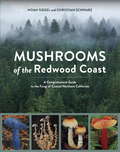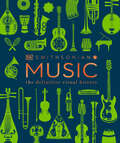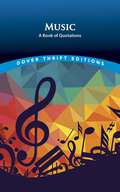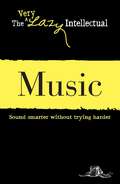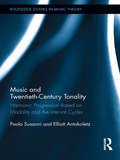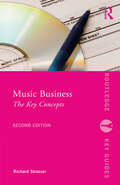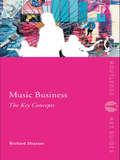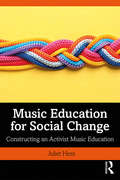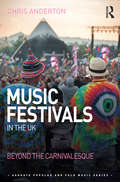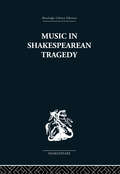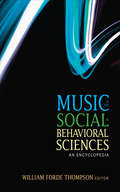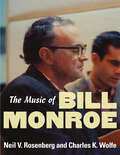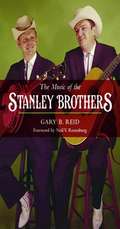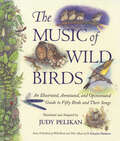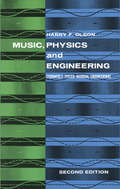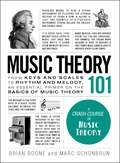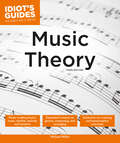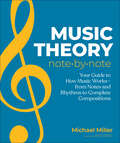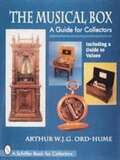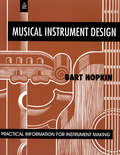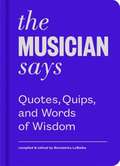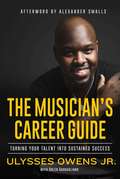- Table View
- List View
Mushrooms of the Redwood Coast: A Comprehensive Guide to the Fungi of Coastal Northern California
by Christian Schwarz Noah SiegelA comprehensive and user-friendly field guide for identifying the many mushrooms of the northern California coast, from Monterey County to the Oregon border. Mushrooms of the Redwood Coast will help beginning and experienced mushroom hunters alike to find and identify mushrooms, from common to rare, delicious to deadly, and interesting to beautiful. This user-friendly reference covers coastal California from Monterey County to the Oregon border with full treatments of more than 750 species, and references to hundreds more. With tips on mushroom collecting, descriptions of specific habitats and biozones, updated taxonomy, and outstanding photography, this guide is far and away the most modern and comprehensive treatment of mushrooms in the region. Each species profile pairs a photograph with an in-depth description, as well as notes on ecology, edibility, toxicity, and look-alike species. Written by mushroom identification experts and supported by extensive field work, Mushrooms of the Redwood Coast is an indispensable guide for anyone curious about fungi.From the Trade Paperback edition.
Music: The Definitive Visual History (DK Definitive Visual Encyclopedias)
by DKProduced in association with the Smithsonian and including images from The National Music Museum in South Dakota, Music: The Definitive Visual History guides readers through the progression of music since its prehistoric beginnings, discussing not just Western classical music, but music from all around the world.Telling the story of musical developments, era by era, linking musical theory, technology, and human genius into the narrative, Music: The Definitive Visual History profiles the lives of groundbreaking musicians from Mozart to Elvis, takes an in-depth look at the history and function of various instruments, and includes listening suggestions for each music style.Anyone with an interest in music will enjoy learning about the epic journey the art has taken over the years and will learn to appreciate music with a new ear.
Music: A Book of Quotations (Dover Thrift Editions: Speeches/quotations Ser.)
by Herb GalewitzMore than 400 memorable quotes are arranged alphabetically by author, from Fred Allen ("When Jack Benny plays the violin, it sounds as if the strings are still back in the cat.") to Friedrich Nietzsche ("Is Wagner a human being at all? Is he not rather a disease?"), many more.
Music
by Adams MediaIs your musical knowledge limited to the Top 40? Have trouble telling the difference between Mozart and Beethoven? Fear not! The Very Lazy Intellectual: Music introduces you to both the world's most influential musicians and the origins of every style of music. With information on everyone from Bach to Nirvana and styles from classical to punk, you'll be jamming in no time.
Music: Sound smarter without trying harder
by Adams MediaIs your musical knowledge limited to the Top 40? Have trouble telling the difference between Mozart and Beethoven? Fear not! The Very Lazy Intellectual: Music introduces you to both the world’s most influential musicians and the origins of every style of music. With information on everyone from Bach to Nirvana and styles from classical to punk, you’ll be jamming in no time.
Music and Twentieth-Century Tonality: Harmonic Progression Based on Modality and the Interval Cycles (Routledge Studies in Music Theory)
by Elliott Antokoletz Paolo SusanniThis book explores the web of pitch relations that generates the musical language of non-serialized twelve-tone music and supplies both the analytical materials and methods necessary for analyses of a vast proportion of the 20th century musical repertoire. It does so in a simple, clear, and systematic manner to promote an easily accessible and global understanding of this music. Since the chromatic scale is the primary source for the pitch materials of 20th-century music, common sub-collections of the various modes and interval cycles serve as the basis for their mutual transformation. It is precisely this peculiarity of the non-serialized twelve-tone system that allows for an array of pitch relations and modal techniques hitherto perceived difficult if not impossible to analyze. Susanni and Antokoletz present the principles, concepts, and materials employed for analysis using a unique theoretic-analytical approach to the new musical language. The book contains a large number of original analyses that explore a host of composers including Ives, Stravinsky, Bartók, Messiaen, Cage, Debussy, Copland, and many more, providing insight into the music of the tonal revolution of the twentieth century and contributing an important perspective to how music works in general.
Music Business: The Key Concepts (Routledge Key Guides)
by Richard StrasserMusic Business: The Key Concepts, second edition, is a comprehensive guide to the terminology commonly used in the music business today.This updated second edition responds to the music industry's increasingly digital and ever-evolving environment, with definitions from a number of relevant fields, including: general business marketing e-commerce intellectual property law economics entrepreneurship In an accessible A-Z format and fully cross-referenced throughout, this book is essential reading for music business students as well as those interested in the music industry.
Music Business: The Key Concepts (Routledge Key Guides)
by Richard StrasserMusic Business: The Key Concepts is a comprehensive guide to the terminology commonly used in the music business today. It embraces definitions from a number of relevant fields, including: general business marketing e-commerce intellectual property law economics entrepreneurship In an accessible A-Z format and fully cross-referenced throughout, this book is essential reading for music business students as well as those interested in the music industry.
Music Education for Social Change: Constructing an Activist Music Education
by Juliet HessMusic Education for Social Change: Constructing an Activist Music Education develops an activist music education rooted in principles of social justice and anti-oppression. Based on the interviews of 20 activist-musicians across the United States and Canada, the book explores the common themes, perceptions, and philosophies among them, positioning these activist-musicians as catalysts for change in music education while raising the question: amidst racism and violence targeted at people who embody difference, how can music education contribute to changing the social climate? Music has long played a role in activism and resistance. By drawing upon this rich tradition, educators can position activist music education as part of a long-term response to events, as a crucial initiative to respond to ongoing oppression, and as an opportunity for youth to develop collective, expressive, and critical thinking skills. This emergent activist music education—like activism pushing toward social change—focuses on bringing people together, expressing experiences, and identifying (and challenging) oppressions. Grounded in practice with examples integrated throughout the text, Music Education for Social Change is an imperative and urgent consideration of what may be possible through music and music education.
Music Festivals in the UK: Beyond the Carnivalesque (Ashgate Popular and Folk Music Series)
by Chris AndertonThe outdoor music festival market has developed and commercialised significantly since the mid-1990s, and is now a mainstream part of the British summertime leisure experience. The overall number of outdoor music festivals staged in the UK doubled between 2005 and 2011 to reach a peak of over 500 events. UK Music (2016) estimates that the sector attracts over 3.7 million attendances each year, and that music tourism as a whole sustains nearly 40,000 full-time jobs. Music Festivals in the UK is the first extended investigation into this commercialised rock and pop festival sector, and examines events of all sizes: from mega-events such as Glastonbury Festival, V Festival and the Reading and Leeds Festivals to ‘boutique’ events with maximum attendances as small as 250. In the past, research into festivals has typically focused either on their carnivalesque heritage or on developing managerial tools for the field of Events Management. Anderton moves beyond such perspectives to propose new ways of understanding and theorising the cultural, social and geographic importance of outdoor music festivals. He argues that changes in the sector since the mid-1990s, such as professionalisation, corporatisation, mediatisation, regulatory control, and sponsorship/branding, should not necessarily be regarded as a process of transgressive 'alternative culture’ being co-opted by commercial concerns; instead, such changes represent a reconfiguration of the sector in line with changes in society, and a broadening of the forms and meanings that may be associated with outdoor music events.
Music in Context: Manuscripts and Medieval Song
by Deeming, Helen and Leach, Elizabeth Eva Helen Deeming Elizabeth Eva LeachThe manuscript sources of medieval song rarely fit the description of 'songbook' easily. Instead, they are very often mixed compilations that place songs alongside other diverse contents, and the songs themselves may be inscribed as texts alone or as verbal and musical notation. This book looks afresh at these manuscripts through ten case studies, representing key sources in Latin, French, German, and English from across Europe during the Middle Ages. Each chapter is authored by a leading expert and treats a case study in detail, including a listing of the manuscript's overall contents, a summary of its treatment in scholarship, and up-to-date bibliographical references. Drawing on recent scholarly methodologies, the contributors uncover what these books and the songs within them meant to their medieval audience and reveal a wealth of new information about the original contexts of songs both in performance and as committed to parchment.
Music in Shakespearean Tragedy
by F W SternfeldFirst published in 1963. When originally published this book was the first to treat at full length the contribution which music makes to Shakespeare's great tragedies, among them Hamlet, Othello, and King Lear. Here the playwright's practices are studied in conjunction with those of his contemporaries: Marlowe and Jonson, Marston and Chapman. From these comparative assessments there emerges the method that is peculiar to Shakespeare: the employment of song and instrumental music to a degree hitherto unknown, and their use as an integral part of the dramatic structure.
Music in the Social and Behavioral Sciences: An Encyclopedia
by William Forde ThompsonThis first definitive reference resource to take a broad interdisciplinary approach to the nexus between music and the social and behavioral sciences examines how music affects human beings and their interactions in and with the world. The interdisciplinary nature of the work provides a starting place for students to situate the status of music within the social sciences in fields such as anthropology, communications, psychology, linguistics, sociology, sports, political science and economics, as well as biology and the health sciences. Features: Approximately 450 articles, arranged in A-to-Z fashion and richly illustrated with photographs, provide the social and behavioral context for examining the importance of music in society. Entries are authored and signed by experts in the field and conclude with references and further readings, as well as cross references to related entries. A Reader's Guide groups related entries by broad topic areas and themes, making it easy for readers to quickly identify related entries. A Chronology of Music places material into historical context; a Glossary defines key terms from the field; and a Resource Guide provides lists of books, academic journals, websites and cross-references. The multimedia digital edition is enhanced with video and audio clips and features strong search-and-browse capabilities through the electronic Reader’s Guide, detailed index, and cross references. Music in the Social and Behavioral Sciences, available in both multimedia digital and print formats, is a must-have reference for music and social science library collections.
The Music of Bill Monroe (Music in American Life)
by Neil V. Rosenberg Charles K. WolfeSpanning over 1,000 separate performances, The Music of Bill Monroe presents a complete chronological list of all of Bill Monroe’s commercially released sound and visual recordings. Each chapter begins with a narrative describing Monroe’s life and career at that point, bringing in producers, sidemen, and others as they become part of the story. The narratives read like a “who’s who” of bluegrass, connecting Monroe to the music’s larger history and containing many fascinating stories. The second part of each chapter presents the discography. Information here includes the session’s place, date, time, and producer; master/matrix numbers, song/tune titles, composer credits, personnel, instruments, and vocals; and catalog/release numbers and reissue data. The only complete bio-discography of this American musical icon, The Music of Bill Monroe is the starting point for any study of Monroe’s contributions as a composer, interpreter, and performer.
The Music of the Stanley Brothers (Music in American Life)
by Gary B. Reid Neil V. RosenbergThe Music of the Stanley Brothers brings together forty years of passionate research by scholar and record label owner Gary Reid. A leading authority on Carter and Ralph Stanley, Reid augments his own vast knowledge of their music with interviews, documents ranging from books to folios sold by the brothers at shows, and the words of Ralph Stanley, former band members, guest musicians, session producers, songwriters, and bluegrass experts. The result is a reference that illuminates the Stanleys' art and history. It is all here: dates and locations; the roster of players on well-known and obscure sessions alike; master/matrix and catalog/release numbers, with reissue information; a full discography sorting out the Stanleys' complex recording history; the stories behind the music; and exquisitely informed biographical notes that place events in the context of the brothers' careers and lives. Monumental and indispensable, The Music of the Stanley Brothers provides fans and scholars alike with a guide for immersion in the long career and breathtaking repertoire of two legendary American musicians.
The Music of Wild Birds: An Illustrated, Annotated, and Opinionated Guide to Fifty Birds and Their Songs
by Judy Pelikan F. Schuyler MathewsOne hundred years ago, F. Schuyler Mathews, an erudite naturalist and birder, theorized that birds sing first for love of music, and second for love of the lady. To expand on his theory, he actually scored the songs of birds in the wild. His charming text and bird-by-bird annotations were compiled into a guide called Field Book of Wild Birds and Their Music. This extraordinary work has now been lavishly illustrated and adapted for a new audience. Each bird is meticulously rendered by artist Judy Pelikan in full-color illustrations that feature not only the birds, but also their nests, eggs, and feathers. And every song is represented by its written musical score, which Mathews expertly explains in a way that both musicians and non-musicians can enjoy. As Mathews points out, the music of wild birds is everywhere--in poems, children's nursery songs, as well as in the works of the great composers: the Black-billed Cuckoo's call appears near the close of Beethoven's Pastoral Symphony; the Nashville Warbler's song is found in the opening bars of Rossini's Carovale, and the Meadowlark's song is remarkably like the first two bars of Alfredo's song in La Traviata. He reveals how a bird's character is reflected in its song: the Baltimore Oriole is a sharp-billed, sharp-witted character, and his remarks are as incisive and crisp as the toots of a steam whistle. And he reminds us of the words of our great poets--Wordsworth, Emerson, Sir Walter Scott--and their descriptions of the very same birds and their music. This classic, useful, and completely original guide will put a song into the heart of novice and experienced birder alike.
Music, Physics and Engineering (Dover Books On Music Ser.)
by Harry F. OlsonNow thoroughly revised and enlarged, this book offers the most comprehensive coverage available of all aspects of the production, reception, and reproduction of sound. Written clearly and concisely, all its chapters can be understood without specialized training in music, physics, engineering, or mathematics.Dr. Olson discusses the nature of sound waves; explains the division of sound into scale patterns and the traditional method of notating them; describes the individual characteristics of all musical instruments currently in use (including the human voice); shows how the ears hear; discusses concert hall and recording studio acoustics, amplification systems, etc; describes the elements of sound reproduction systems from the telephone to the stereo record player; and concludes with a new chapter on the production, development, and potentialities of electronic music.Under these broad headings, readers will find a close analysis of the way in which a violin produces sound; descriptions of carbon, crystal, dynamic, velocity, and unidirectional microphones; a comparison of the relative absorbency of 22 acoustic materials, building materials, and objects; a description of how music can be produced by a digital computer; and much, much more. Conductors will find suggestions on positioning their orchestras; performers will understand the dynamics of their instruments; recording engineers and acousticians will discover a remarkably comprehensive reference work; and music teachers, students, physicists, and enthusiasts in general will find easy access to a vast wealth of information.
Music Sketches
by Friedemann SallisThe term 'music sketch' relates to the vast variety of documents that are used by composers to work out a musical technique or idea and to prepare their work for performance or publication. These documents can often provide crucial insights into authorship, biography, editorial practice and musical analysis. This Introduction provides students and scholars with the knowledge and skills they need to embark on research projects involving the study of composers' working documents. Presenting examples of the compositional process over a 400-year period, it includes a selection of detailed case studies on how sketches were created and the techniques that were used, such as transcription and the sorting of loose leaves. Numerous illustrations of manuscripts and autographs, many of which have never been published before, show how these vital documents can be used to better understand the compositional processes of the seventeenth and eighteenth centuries.
Music Theory 101: From keys and scales to rhythm and melody, an essential primer on the basics of music theory (Adams 101 Series)
by Brian Boone Marc SchonbrunLearn the basics of music theory in this comprehensive and easy-to-understand guide.From classical to hard rock, and jazz to hip hop, music is constantly evolving, but many of the basics have stayed the same. Understanding these basics is key to becoming a successful musician and well-rounded music lover. Music Theory 101 covers everything novice musicians and lifelong learners need to know, including: -How to read sheet music -Understanding the construction of chords and scales -The different rhythm and time signatures -How keys are identified and organized Full of music trivia, music history, comprehensive instruction, and visual aids of scales, music symbols, and chords throughout, Music Theory 101 is the essential guide you need for a crash course in music theory that even professional musicians would envy.
Music Theory, 3E (Idiot's Guides)
by Michael MillerMusic theory doesn&’t need to be complicated, and this guide will show you how to make it simple. Idiot's Guides: Music Theory, Third Edition, is a concise and clear guide that teaches any budding musician or experienced musician how to read musical notation by navigating the basics of reading and composing music. Here&’s what you&’ll find: • The basics of tones, including pitches, clefs, scales, intervals, and major and minor keys • The building blocks of rhythm, including note values, basic notation, time signatures, and tempo, dynamics, and navigation • How tunes are created, starting with melodies, chords, chord progressions, and phrases and forms • The basics of accompaniment, including transcribing, accompanying melodies, and transposing to other keys • Composing and arranging, including coverage of musical genres and forms, how to compose your own music, arranging for voices and instruments, working with lead sheets and scores, and performing your music • Helpful reference appendixes, including a glossary, chord charts, and instrument ranges • Expanded online ear-training and transcribing exercise content, including exercises at the end of each chapter and an answer key appendix
Music Theory Note by Note: Your Guide to How Music Works—From Notes and Rhythms to Complete Compositions
by Michael MillerTake note: You can enjoy music analysis.This concise and clear guide to simplified music theory teaches readers who play music by ear how to read musical notation by guiding them through the basics of reading and composing music to share with others.In this revised edition, renowned music author Michael Miller will help you learn:The basics of tones, including pitches, clefs, and major and minor keysThe building blocks of rhythm, including basic notation, time signatures, and tempoHow to create tunes, starting with melodies, chords, chord progressions, and phrases and formsComposing and arranging your own music, including coverage of musical genres and forms, arranging for voices and instruments, working with scores, and performing your musicThe basics of accompaniment, including transcribing, accompanying melodies, and transposing to other keysMichael will also share online ear training and transcribing exercises to help you better understand music analysis. If your goal is to learn how to read and compose music, Music Theory Note by Note will provide just what you need to become successful.
The Musical Box: Including a Guide to Values
by Arthur W.J.G. Ord-HumeMusical boxes have been in existence since the early part of the 19th century. This book is a catalog for collectors of musical boxes. It describes the makers and models along with occasional comments about their characteristics and which ones might be the most desirable.
Musical Instrument Design: Practical Information for Instrument Making (Sound Design Ser.)
by Bart Hopkin John ScovilleThis is an encyclopedic, large-format book containing hundreds of illustrations. While not geared toward making conventional instruments, Musical Instrument Design provides all the information that anyone (amateur or professional) should ever need to construct an amazingly wide variety of percussion, string, and wind instruments. Includes many designs along with parts lists and detailed construction instructions.
The Musician Says
by Benedetta LobalboThe Musician Says is an all-access backstage pass to the world of singers, songwriters, composers, and instrumentalists--all those who have a relationship with the Muse and have experienced the sacrifices, satisfactions, and frustrations it brings. You'll hear from an eclectic group that spans centuries and genres, from Mozart to Mick Jagger, Louis Armstrong to Jay Z, Dolly Parton to Lady Gaga, and many more. Paired like unlikely guests at a backstage party, this unruly crew riffs about the blessings and curses of the musician's life. This collection of intriguing and provocative quotations will remind anyone who has dreamed of playing Carnegie Hall (or maybe just mastering three chords) that the creative process bridges time and place, and that music is indeed a universal language.
The Musician's Career Guide: Turning Your Talent into Sustained Success
by Ulysses Owens Jr Arlen GargaglianoAn Engaging and Accessible Guide to Achieving Sustained Access in the Music Industry As a musician, how can you blend art and survival and still keep loving the business? The Musician&’s Career Guide, written from the perspective of someone who has engaged in the daily struggle that all artists encounter, provides clear strategic support and advice in a knowledgeable, reader-friendly voice.From preparing for an audition to business planning to protecting one&’s mental and emotional well-being, The Musician&’s Career Guide marries practical tips with in-depth resources, anecdotes and stories to learn from, and comments for consideration and self-reflection. This book is a tool musicians can use to develop a realistic roadmap for success in the careers they desire. Part textbook, part self-directed learning tool, and full mentor, this information-packed text speaks with the voice of experience in a way that is realistic and attainable. The authors address topics including the following fundamental areas: Career development Touring Roles within the music industry Recording deals and industry PR and marketing for artists Keys to community engagement The mental side of being a musicianThe path and commitment to mastery as professional musician The Musician's Career Guide offers a foundation for both new and experienced musicians who yearn to clarify and achieve their individual goals of personal success and fulfillment through their craft. It's essential reading for any musician.
